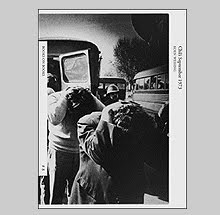A Pile of Good Books
I receive many books in the mail, both ones I have requested and many that I hadn't. Some are revelatory which inspire words and others don't. I even receive many which I like but they don't inspire many words beyond a couple sentences. I usually keep those close by for a few extra weeks, hoping for more thoughts to brew and words to form - most times that doesn't happen and I move on to an easier subject. This post is a list of books that fall into that latter category.
If you are lucky enough to live in Berlin you might discover an issue of Bertrand Fleuret's Remora hanging on a light post or garbage pile. 16 pages of Bertrand's idiosyncratic photographs xeroxed for the masses to enjoy, ignore, tear apart or mistakenly piss on. Each is like a hand in the water signaling where the ship has sunk.
Mike Slack's High Tide was published in a very limited number (75 copies) by The Ice Plant in 2006. Mike's brilliant trilogy of books OKOKOK, Scorpio, and Pyramids feature his quirky polaroids of small details which fill the world with meaning. High Tide is a small catalog of polaroids made off TV screens of actors in close-up and with eyes closed. More like meditating than acting, each seems to have momentarily dropped their profession and found a personal truth.
Ed Templeton's Coming to Grips was released in an edition of 500 by the Japanese publisher Super Labo in 2009. Coming to Grips is a small 28 page booklet/'zine of portraits of Templeton's friends looking like they hit life head on. The physically damage is metaphor for the psychological within a community where innocence is lost quickly. Not so much a warning but a celebration of lives lived mostly on their own terms.
Lucia Nimcova's Unofficial published by Zoneattive Edizioni, 2008 (ISBN: 88-89303-08-5) is two books in a cardboard box which question the legacy of socialism in Nimcova's hometown of Humenné, Slovakia. One book is of mostly black and white photographs made throughout the 1980s by Juraj Kammer - a contracted professional photographer who documented social and political events.
The other book is made of contemporary color photographs taken by Lucia Nimcova, some of which comment on the imagined political power and lack of credible influence indicative of the town's leaders.
Guadalupe Gaona's Pozo de Aire (Well of Air) published by Vox in 2009 (ISBN: 978-987-1073-24-5) is a small hardcover book of image and poetry about memory, loss, and family. The elephant in the room is the disappearance of Gaona's father to the hand's of the military junta of Argentina in 1977 but Pozo de Aire isn't saturated with the overdramatic which could so easily taint such a project. Instead, the family summer villa on a lake in the mountains provides a meditative setting where old family photos flashback and present photos question the tranquility of the surroundings.
Terri Weifenbach's Another Summer sits in interesting relation to Pozo de Aire. Published by The Thunderstorm Press in 2009 (ISBN: 0-9841944-0-1) Another Summer is a small book of Weifenbach's recent work, directly personal it is centered around a summer holiday and discoveries made by a couple of bleach blond children. One gets the sense of Weifenbach trying to use photography to stave off time and remain in what seems to be an idyllic setting for growth and learning for these two children. For me, it achieves a melancholy increased by nostalgia that is hard to take - what does that say about me?
Thomas Manneke's Vilnius was published in 2006 by Artimo (ISBN: 90-8546-050-6). For 4 months Manneke lived in the Lithuanian city of Vilnius, photographing without a plan and "wherever people would take me." The result is a partial portrait of a city and its youth culture in transition now that the state has become a part of the European Union. As with Manneke's other book Odessa (Schaden, 2008), many of the portraits are of young women - most seem to have become his muses.
Wout Berger's Like Birds was published in 2009 by Galerie van Kranendonk (ISBN: 978-90-72697-09-7). In Like Birds Berger drops his view camera to the ground for often exquisitely beautiful, spatially confusing photographs of plant life. I find the book oddly inconsistent with half of the photographs inspired and surprising and the other half familiar and ordinary. A brief suite of pictures made of cityscapes might be introducing the notion of man's negative impact on nature but the vibrancy of color and wealth of the plant life belies such a reading.
On sending books for review: I really appreciate people's generosity but I would rather not receive books without request. I respect too much the passion, money and effort involved in making any book that it makes me feel bad when something shows up unannounced and doesn't appeal to my fickle tastes. You are welcome to send an email introduction but realize that the chances something will inspire a posting are very slim and I would rather save you the expense and waste of a book. Thank you for your understanding.


















